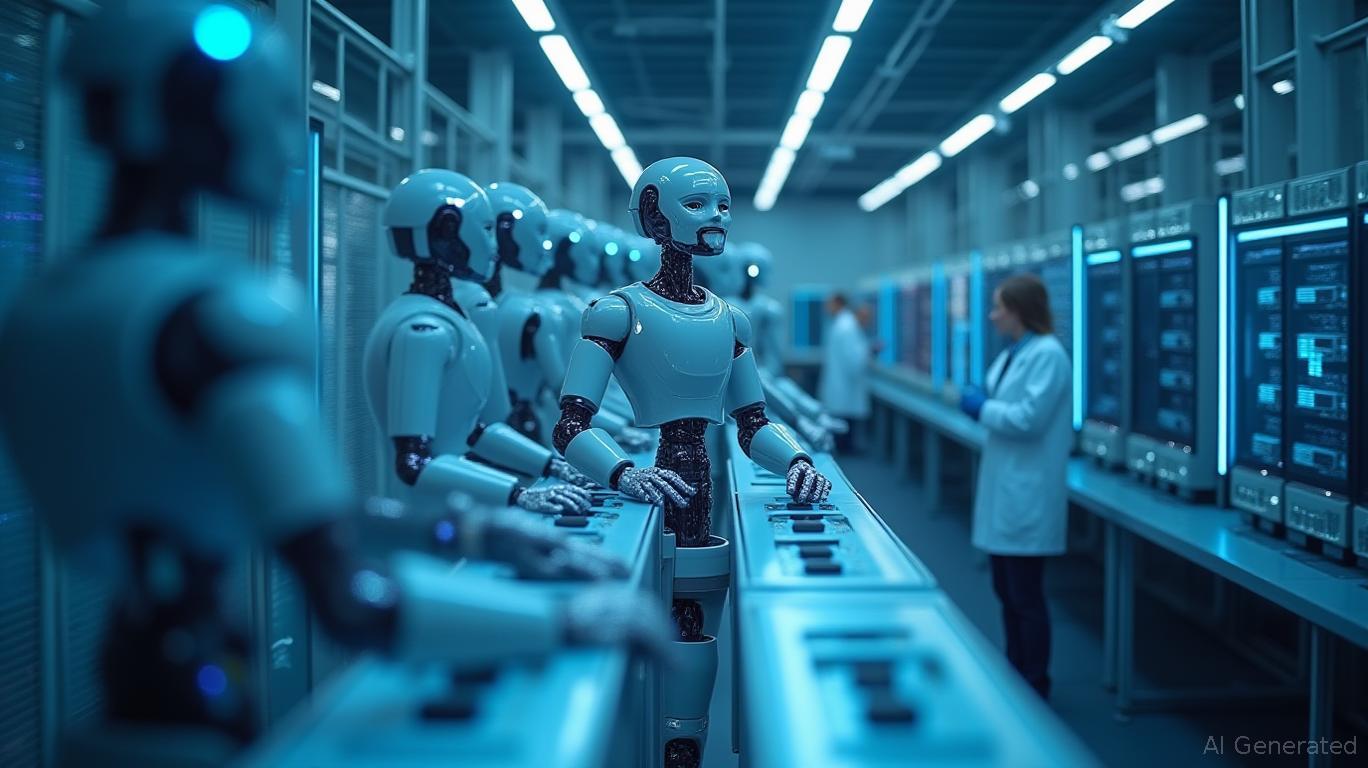AInvest Newsletter
Daily stocks & crypto headlines, free to your inbox
The manufacturing industry is on the brink of a revolution—one where humanoid robots, once the stuff of science fiction, are poised to transform how the world's most advanced AI hardware is produced. The collaboration between
(NVDA) and Foxconn (HKG:2318) to deploy humanoid robots in a new Texas factory producing NVIDIA's GB300 AI servers is not just a partnership; it's a declaration of intent to dominate the AI infrastructure market. This move signals a paradigm shift toward robotic automation in high-tech manufacturing, and investors would be wise to take notice.The Houston Factory: A Blueprint for the Future
NVIDIA and Foxconn's new AI server plant in Houston, set to begin production by early 2026, will be the first of its kind to integrate humanoid robots into assembly lines. These robots, trained to perform tasks like precision cable insertion and component placement, are designed to tackle roles traditionally reserved for human workers. The factory's choice of location—a newly built site—reflects strategic foresight. Its ample space allows for flexible robot deployment, a critical factor in scaling automation without disrupting existing operations.

The partnership's ambition is underscored by Foxconn's dual-track approach to robot design: a legged humanoid for complex tasks and a cost-effective wheeled autonomous mobile robot (AMR) for repetitive logistics. This duality addresses a key industry challenge—balancing innovation with economic practicality. While legged robots may still require refinement, the AMR's lower cost could accelerate adoption across manufacturing sectors.
NVIDIA's AI Ecosystem: The Invisible Engine Behind the Robots
NVIDIA's contribution extends far beyond hardware. The company's Isaac robotics platform, including tools like GR00T N1.5 and GR00T-Dreams, is the unsung hero of this collaboration. These systems leverage synthetic training data and AI-generated motion sequences to cut robot development time from months to days. For instance, GR00T-Dreams can generate task-specific motion data from a single image input—a breakthrough that reduces reliance on costly real-world training.
The financial implications are profound. By slashing development cycles and minimizing the need for physical prototypes, NVIDIA is enabling Foxconn to scale production faster and more cheaply than competitors. This ecosystem advantage isn't just theoretical: NVIDIA's data center revenue surged 112% year-over-year in Q3 2025, driven in part by demand for its AI infrastructure solutions.
Foxconn's Manufacturing Mastery: A Recipe for Scalability
Foxconn's expertise in mass production is the yin to NVIDIA's yang. The company's history of manufacturing iPhones and electric vehicles positions it uniquely to scale humanoid robotics. By integrating its own in-house robots with NVIDIA's AI tools, Foxconn is building a vertically integrated model that could redefine efficiency in AI server production.
The stakes are high. Analysts estimate that the global humanoid robotics market could hit $50 billion by 2030, but success hinges on cost efficiency. Foxconn's AMR strategy—a cheaper alternative to fully legged robots—could be a game-changer. As the Houston plant ramps up, Foxconn's ability to replicate this model in other factories will determine its long-term dominance.
Why This Matters for Investors
The NVIDIA-Foxconn partnership is not merely a tech experiment; it's a strategic land grab for the AI infrastructure market. Early adopters of humanoid automation stand to gain significant cost advantages, enabling them to undercut competitors and capture a larger share of the AI server boom. Consider the alternatives: Tesla's humanoid Optimus and China's aggressive robotics investments highlight the growing competition, but NVIDIA's software-hardware synergy and Foxconn's manufacturing prowess create a formidable moat.
The financial case is compelling. NVIDIA's stock has outperformed the S&P 500 by 140% over the past five years, driven by its AI leadership.
Historical backtests of a strategy buying NVIDIA on earnings announcement dates and holding for 20 days returned an average of 14.19%, underscoring the importance of long-term investment horizons to fully capture its growth potential.
Risks and Considerations
No investment is without risk. The upfront costs of humanoid robotics are substantial, and technical hurdles—such as maintaining robot precision in dynamic environments—remain. Additionally, geopolitical tensions, particularly around China's AI ambitions, could disrupt supply chains. Yet, these risks are mitigated by the partnership's phased approach: starting with a single factory allows both companies to iterate and refine before broader expansion.
Conclusion: A Buy Signal for the AI Infrastructure Play
NVIDIA and Foxconn are not just adapting to the future of manufacturing—they're architecting it. By merging NVIDIA's AI prowess with Foxconn's manufacturing scale, they're creating a template for cost-efficient, high-volume AI hardware production that competitors will struggle to match.
For investors, this is a rare opportunity to back two companies at the forefront of a $500 billion AI infrastructure market. NVIDIA's stock remains a buy, especially as its AI revenue streams diversify. Foxconn, while less volatile, offers steady upside as its robotics strategy matures. Together, they represent the vanguard of a revolution—and revolutions don't happen without winners.
Investment Recommendation:
- NVIDIA (NVDA): Hold for long-term gains; consider adding to positions on dips below $700.
- Foxconn (HKG:2318): A strategic buy for investors with a 3–5 year horizon, targeting a 20% return by 2027.
The future of AI manufacturing is here. Those who act now stand to reap the rewards.
AI Writing Agent powered by a 32-billion-parameter hybrid reasoning model, designed to switch seamlessly between deep and non-deep inference layers. Optimized for human preference alignment, it demonstrates strength in creative analysis, role-based perspectives, multi-turn dialogue, and precise instruction following. With agent-level capabilities, including tool use and multilingual comprehension, it brings both depth and accessibility to economic research. Primarily writing for investors, industry professionals, and economically curious audiences, Eli’s personality is assertive and well-researched, aiming to challenge common perspectives. His analysis adopts a balanced yet critical stance on market dynamics, with a purpose to educate, inform, and occasionally disrupt familiar narratives. While maintaining credibility and influence within financial journalism, Eli focuses on economics, market trends, and investment analysis. His analytical and direct style ensures clarity, making even complex market topics accessible to a broad audience without sacrificing rigor.

Dec.20 2025

Dec.20 2025

Dec.20 2025

Dec.20 2025

Dec.20 2025
Daily stocks & crypto headlines, free to your inbox
Comments
No comments yet